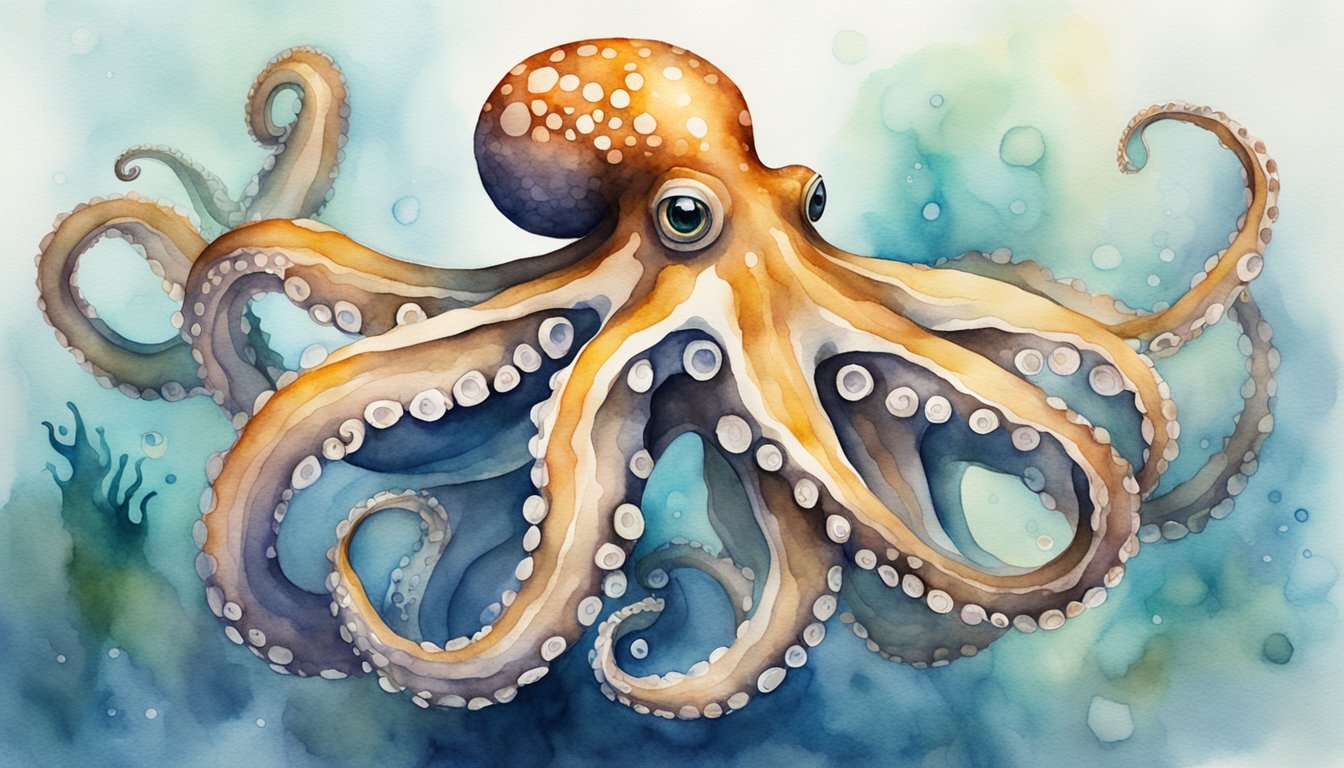Anatomy and Physiology

The common octopus (Octopus vulgaris) is a sophisticated organism with remarkable attributes geared for survival in marine habitats. Its body and sensory systems contribute to its notability within the invertebrate community, showcasing a blend of complexity and evolution unique to cephalopods.
Body Composition and Adaptations
The body of an octopus is primarily comprised of a bulbous structure known as the mantle, which houses vital organs including gills for breathing and a complex nervous system. Extending from the mantle are eight arms, each lined with suckers that grant the octopus exceptional grasping and manipulation abilities. These arms are instrumental in locomotion, capturing prey, and exploring their environment.
Within its mantle cavity, the common octopus operates a sophisticated respiratory system where water is drawn in and expelled, facilitating not only breathing but also locomotion via jet propulsion. An intricate network of neurons, rivaling that of many mammals, extends throughout its body and into its arms, underpinning its ability to solve problems and manipulate objects.
Contrasting with vertebrates, octopuses possess blue blood due to a copper-based molecule called hemocyanin, which is more efficient in cold, low-oxygen environments. They also have a three-part heart system, with two branchial hearts pumping blood through the gills and a systemic heart circulating it to the rest of the body.
Sensory Systems and Intelligence
Octopuses exhibit a high level of intellect, often deemed the most intelligent of all invertebrates, with a hefty proportion of their neurons located in the arms, enabling them to bypass their central nervous system for quicker reflexes and problem-solving abilities. Complex learning and memory tasks can be performed by the common octopus, indicative of their advanced cognitive capabilities.
Their sensory systems are exceedingly refined; suckers are not only powerful tools for gripping but also function as taste and touch receptors, providing detailed information about their surroundings. Sharp vision is another key sensory attribute, with their eyes being capable of detecting polarization of light, an ability not found in humans. This skill assists in hunting and navigation, reinforcing their reputation as formidable predators.
Octopuses have also developed an impressive level of adaptability. This is, in part, due to their capacity for camouflage and the intricate control they have over the chromatophores in their skin, allowing them to change both color and texture to blend seamlessly with their environment.
For more information on the common octopus’s body structure and adaptations, visit Encyclopedia Britannica. To explore the complexities of their sensory systems and intelligence, read through HowStuffWorks.
Habitat, Behavior, and Interaction

The common octopus exhibits a range of intriguing behaviors that allow it to thrive in various oceanic environments. They are notably versatile, occupying both tropical and temperate seas, and have developed sophisticated methods of interaction with their habitat and fellow marine life.
Diet and Hunting Techniques
The common octopus is a carnivore, preying on a variety of sea creatures including crabs, eels, and small fish. Their diet is often governed by the species available in their habitat. To capture prey, an octopus uses its powerful tentacles, each lined with suction cups, to grasp and manipulate its target. It employs cunning hunting strategies such as camouflage, changing its skin color and texture to blend seamlessly with its environment. When threatened, the octopus can expel a cloud of ink to obscure its escape, which it facilitates with a swift jet-propelled motion.
- Prey: crabs, eels, small fish
- Hunting Technique: camouflage, use of tentacles
- Defense Mechanism: ink expulsion, jet propulsion
More about their diet and hunting techniques.
Reproduction and Lifecycle
The reproduction and lifecycle of the common octopus are marked by unique behaviors. Mating entails the male octopus transferring sperm packets to the female using one of its modified arms called the hectocotylus. Following mating, the female lays up to tens of thousands of eggs, which she meticulously guards and cares for in her den until they hatch. During this period, known as the brooding phase, she does not eat and will eventually perish shortly after the eggs hatch. The lifespan of an octopus is relatively short, usually ranging from one to two years.
- Mating Behavior: transfer of sperm packets via hectocotylus
- Egg Care: female guards the eggs, cleans them, aerates them
- Lifespan: one to two years
Insights on reproduction and lifecycle.

